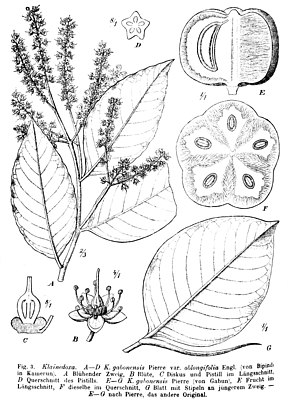Klainedoxa gabonensis
| Klainedoxa gabonensis | ||||||||||||
|---|---|---|---|---|---|---|---|---|---|---|---|---|

Klainedoxa gabonensis |
||||||||||||
| Systematics | ||||||||||||
|
||||||||||||
| Scientific name | ||||||||||||
| Klainedoxa gabonensis | ||||||||||||
| Pierre |
Klainedoxa gabonensis is a tree in the Irvingiaceae family from West and Central Africa to Sudan , Uganda , Zambia and Tanzania .
description
Klainedoxa gabonensis grows as an evergreen tree up to 45–50 meters high. The trunk diameter reaches 120-150 centimeters. Thinner and meter high buttress roots are formed. The gray-brownish bark is easily cracked and peeling off in small pieces.
The alternate and short-stalked, simple leaves are leathery and bare. The short petiole is up to 8 millimeters long. The leaves are entire and ovate, -lanceolate to elliptical, lanceolate or obovate, -eilanceolate. They are about 8-30 inches long and 4-10 inches wide. At the top they are pointed to pointed, the base is rounded to pointed. Long, sloping and reddish stipules are formed, they are up to 10-20 centimeters long and sub-like.
Terminal or axillary panicles up to 15 centimeters long, bald and condensed on the side branches are formed. The hermaphroditic, small and white to pink, short-stalked flowers are five-fold and with a double flower envelope . The small, broadly egg-shaped to roundish sepals are free and up to 2.5 millimeters long. The elliptical to rounded petals are free and up to 3.5 millimeters long. 9-10 relatively short stamens are formed. The upper permanent and fünfkammerige, large, spherical ovary , with a long, conical stylus with a small capitate scar , sitting on / in a fleshy, yellow discus .
Roundish, slightly four-, five-lobed, ribbed and 4-9 centimeters large, matt dark purple to orange, multi-seeded stone fruits with a thin skin are formed. The 4–5 wedge-shaped, very hard, fibrous stone cores each contain an approximately 2 centimeter large, wine-red and elliptical to narrow-egg-shaped, smooth seed . The pulp ( mesocarp ) is slimy and fibrous.
The number of chromosomes is 2n = 26.
Taxonomy
The first description of Basionyms Klainedoxa gabonensis took place (February) 1896th by Jean Baptiste Louis Pierre in Table Herb. L. Pierre, del. E. Delpy. Some synonyms are known.
use
The seeds are edible and are eaten raw, roasted, or made into a paste. The seed fat is similar to shea butter .
The young leaves and bark are used medicinally.
The dark, hard and very heavy, very durable, but difficult to treat wood is known as Éveuss .
literature
- K. Kubitzki : The Families and Genera of Vascular Plants. Vol.XI : Flowering Plants Eudicots , Springer, 2014, ISBN 978-3-642-39416-4 , p. 230 f.
- Quentin Meunier, Carl Moumbogou, Jean-Louis Doucet: Les arbres utiles du Gabon. Presses Agronomiques de Gembloux, 2015, ISBN 978-2-87016-134-0 , p. 210 f, limited preview in the Google book search.
- J. Gérard, D. Guibal, S. Paradis, J.-C. Cerre: Tropical Timber Atlas. Éditions Quæ, 2017, ISBN 978-2-7592-2798-3 , p. 324 ff, limited preview in Google Book Search.
- M. Chudnoff: Tropical Timber of the World. Agriculture Handbook 607, USDA Forest Service, 1984, p. 241, limited preview in Google Book Search.
Web links
- Klainedoxa gabonensis at Useful Tropical Plants.
- Klainedoxa gabonensis at PROTA.
Individual evidence
- ↑ Wild food plants used by Baka people in southeast Cameroon at Treub Maatschappij, May 27, 2019.
- ↑ FJ Breteler: Novitates Gabonenses 55. Manuscript names and drawings of the French botanist Pierre Louis (1833-1905): A discussion about Their validity with some examples of nomenclatural Consequences for the Gabonese flora in particular. In: Adansonia. 27 (2), 2005, pp. 325–335, on pp. 327 f, 333 f, online (PDF; 3.1 MB), at Publications scientifiques du Muséum national d'Histoire.
- ↑ Description by Adolf Engler (April) 1896 in HGAEngler & KAEPrantl, Nat. Plant family 3 (4): 227 online at biodiversitylibrary.org.
- ↑ Klainedoxa gabonensis at KEW Science.